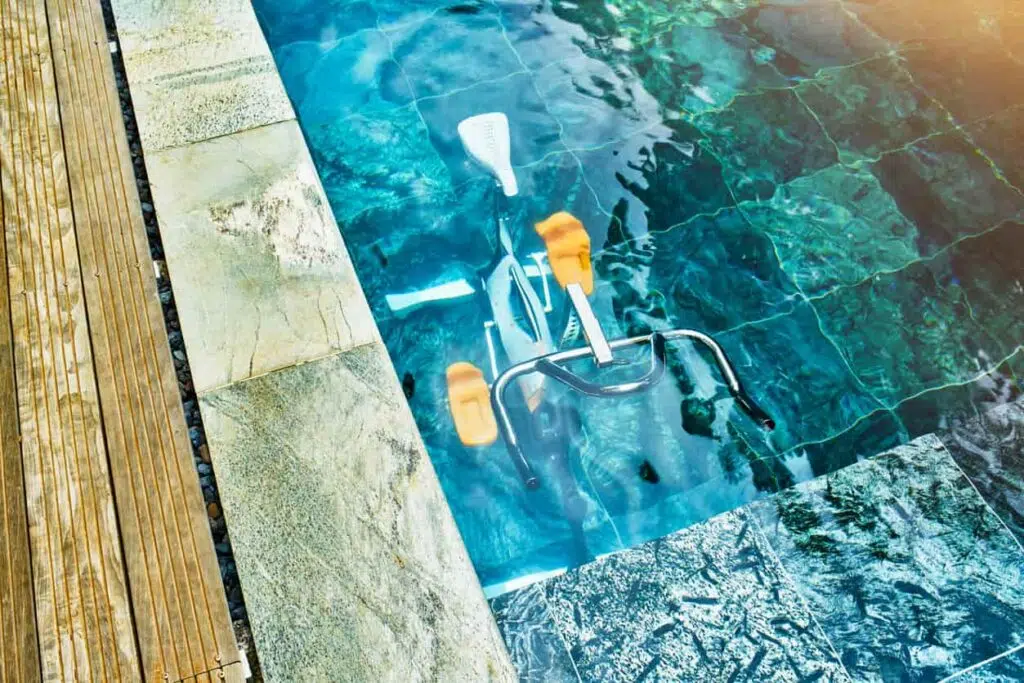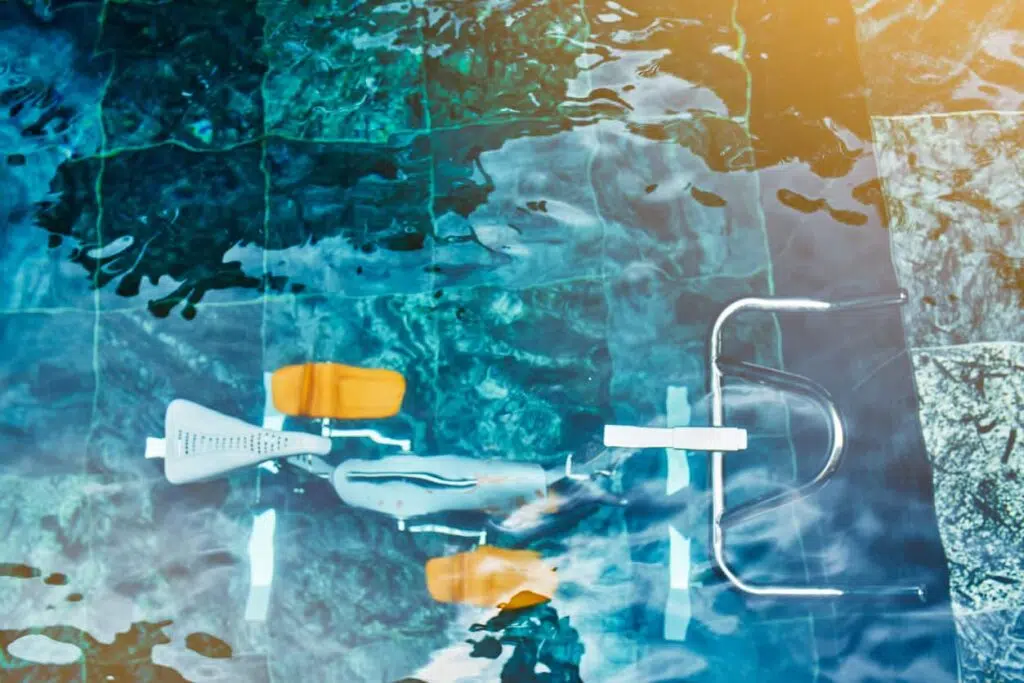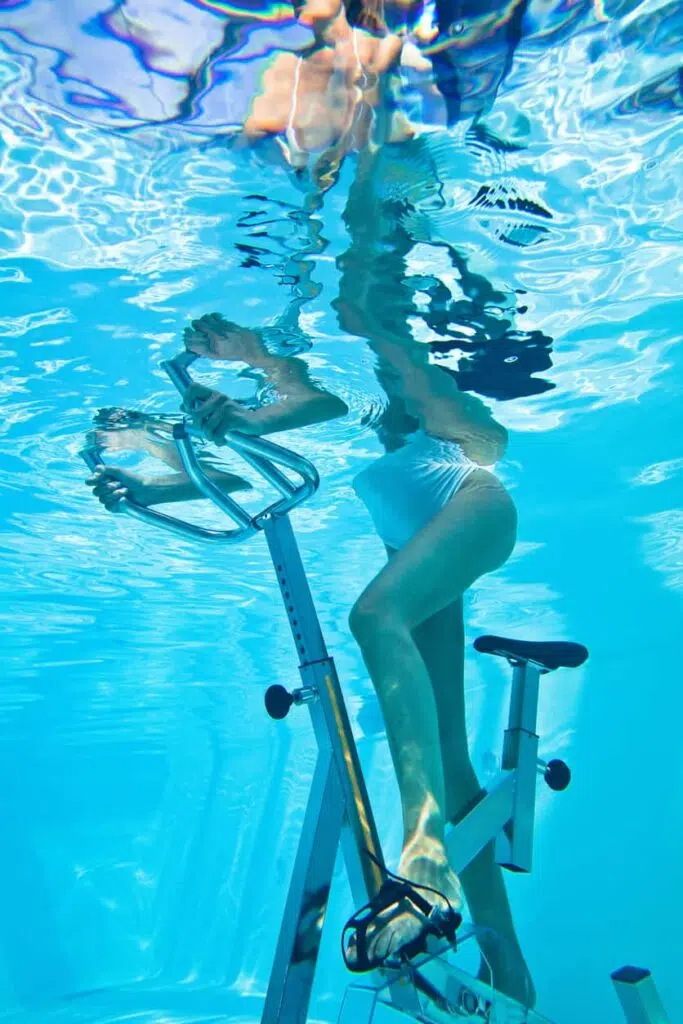Looking to lose a waistline while having fun? Discover the aquabike belly exercise range. It is the ideal solution for burning fat and toning your abs. Discover how this aquatic activity can transform your figure.
What is aquabike?
In this article, we explain the benefits of an aquabike stomach exercise and training programs suitable for all levels. Also learn the importance of warm-up, cool-down and nutrition to optimize your results.
Definition of aquabike
Aquabike, also known as water cycling, is a sporting activity that combines the benefits of cycling with those of aquagym cardio exercises. Practiced in a swimming pool, it consists of pedaling on a bike specially designed for water. Thanks to the natural resistance of the water, each movement is amplified, providing a more intense and complete workout. The aquabike can be combined with aquawork exercises.
The sport appeared in the 1990s in Italy, where physiotherapists initially developed it to help with re-education injured athletes. Its effectiveness was quickly recognized, and it became popular in fitness centers and swimming pools around the world. Today, aquabike is a popular activity for its many benefits, both physically and mentally.
Benefits of aquabiking to lose belly fat
Burn fat
Aquabiking is extremely effective in burning fat and promoting weight loss. The resistance of the water increases the intensity of each movement, putting more strain on your muscles and boosting your metabolism. By pedaling vigorously, you can burn between 300 and 500 calories per 45-minute session. This high calorie expenditure directly contributes to the reduction of fat mass, particularly in the stomach area.
Intense cardiovascular exercise
Aquabike is an intense cardiovascular exercise. Water adds extra resistance, forcing your heart to work harder to deliver needed oxygen to your muscles. This activity significantly improves your cardiorespiratory endurance. By increasing your heart rate steadily and sustainably, aquacycling helps burn calories and reduce abdominal fat, while strengthening your cardiovascular system.
High calorie expenditure
The calorie expenditure of the aquabike is one of its main advantages. Due to the combination of muscular work and cardiovascular effort, you burn a significant amount of calories in a relatively short time. In addition, since water has a massaging effect, it stimulates blood circulation and promotes the elimination of toxins, which can help reduce water retention and refine the silhouette, particularly around the stomach.
Strengthen the stomach
Abdominal work
The aquabike is ideal for strengthening the stomach thanks to the constant use of the abdominal muscles. While pedaling through water, your abdominal muscles have to work hard to stabilize your body and maintain good posture. This continuous activation of deep muscles strengthens and tones your abdominal area. Plus, water creates natural resistance that forces your abs to engage with each movement, making the workout more intense.
Specific exercises on the water bike
To further target the stomach muscles, specific exercises can be performed on the water bike. Here are some examples :
- Pedaling in a semi-recumbent position: Angle your back slightly while pedaling to further engage your abs. This position uses the muscles of the lower abdomen and obliques.
- Knee raises: While pedaling, alternately raise your knees toward your chest. This exercise strengthens your lower abdominal muscles and improves the flexibility of your core.
- Aquatic crunches: In a seated position, pedal gently while performing crunches. Bring your torso toward your knees by contracting your abdominals. This exercise intensifies the work of the upper abdominal muscles.
By integrating these exercises into your aquabike routine, you effectively target the abdominal muscles, contributing to a firmer and sculpted stomach.
Other benefits
No impact on joints
One of the major advantages of aquabike is the absence of impact on the joints. The water supports your weight, reducing pressure on your knees, hips and ankles. This makes it an ideal activity for those suffering from joint pain or injuries. This means you can train intensively without risking trauma to your joints, which is often a problem with land-based exercises.
Improved blood circulation
Aquabiking also improves blood circulation. The massaging effect of the water stimulates blood flow, helping to reduce water retention and swelling. By pedaling through the water, your muscles work against resistance, increasing the efficiency of your blood circulation. This not only promotes better oxygenation of the muscles, but also faster elimination of toxins.
Overall muscle strengthening
In addition to the stomach, aquabike uses all the muscles of the body. Legs, thighs, glutes, arms and even back are actively engaged. This overall solicitation contributes to harmonious muscle strengthening, thus improving your posture and muscle tone. Pedaling through water also engages stabilizer muscles, strengthening your balance and coordination.
Relaxing and motivating exercise
Aquabiking is not only beneficial for the body, it is also a relaxing activity. Contact with water has a calming effect, reducing stress and promoting mental well-being. Additionally, group aquabike sessions are often accompanied by dynamic music, which makes the exercise more motivating and enjoyable. This combination of relaxation and motivation makes aquabike a complete activity for body and mind.
Warming up
Importance of warming up
Warming up is a crucial step before any aquabike session. It prepares your body for exercise by gradually increasing the temperature of your muscles and activating your blood circulation. A good warm-up reduces the risk of injuries, such as sprains or strains, and improves your overall performance. Additionally, it allows your mind to focus and mentally prepare for training, maximizing the benefits of your session.
Warm-up exercises on the water bike
For an effective warm-up on the water bike, start with gentle, gradual movements. Here are some specific exercises:
- Slow pedaling: Start by pedaling slowly for 5 to 10 minutes. This movement prepares your legs and joints for exercise while gradually increasing your heart rate.
- Ankle flexions: While pedaling slowly, focus on flexing and extending your ankles. This helps warm up your calf muscles and improve mobility in your joints.
- Arm movements: While pedaling, make circular movements with your arms, alternating between forward and backward circles. This warms up the muscles in your shoulders and back, ensuring better coordination.
- Gentle stretches: Finish with a few gentle stretches for the main muscles used: the quadriceps, hamstrings and calves. Hold each stretch for 15 to 20 seconds, without straining.
By integrating these exercises into your warm-up routine, you are effectively preparing your body for training, thus maximizing the benefits of your aquabike session.
Abdominal strengthening exercises
Aquatic crunches
Water crunches are a great way to target the upper abdominal muscles. To do them, sit on the saddle of the water bike with your hands on the handles. Lean your torso back slightly while keeping your back straight. By contracting your abs, bring your torso towards your knees.
Make sure to engage your abs throughout the movement. Avoid pulling on your neck or shoulders. Focus on a controlled, smooth contraction, breathing deeply with each repetition.
To increase the intensity, you can hold water dumbbells in your hands or increase the speed of crunches. You can also try lifting your legs simultaneously for even more intense lower abdominal work.
Aquatic Obliques
Aquatic obliques target the side abdominal muscles. To do them, sit on the saddle and hold on firmly to the handles. Twist your torso to the right while pedaling, then to the left, alternating sides.
Keep your hips stable and focus on rotating your torso. Engage your oblique muscles with each rotation and be sure to maintain a consistent pace.
To intensify this exercise, increase the rotation speed or use water weights to add additional resistance. You can also try doing deeper rotations, almost touching your elbows to opposite knees.
Other abdominal exercises
List of other abdominal exercises to do on the water bike
- Pedaling with knee lift: This exercise works the lower abdominal muscles. In a seated position, pedal while alternately raising your knees toward your chest. Make sure to contract your abdominals with each knee lift to maximize the work of the muscles.
- Single leg pedaling: This movement engages the stabilizer muscles and abdominals. Pedal with one leg for 30 seconds, then switch legs. This imbalance strengthens the abdominals and improves coordination.
- Twist with handlebars: In a seated position, hold the handlebar grips and twist your torso from left to right while pedaling. This movement strengthens the obliques and improves core flexibility.
- Pedaling in plank position: Place your forearms on the handlebars and extend your legs back into a plank position. Pedal gently in this position to engage your abs and stabilizer muscles.
Cardiovascular exercises
High Intensity Intervals: High-intensity intervals (HIIT) on the water bike are great for burning calories and strengthening the abs. Alternate between periods of fast, intense pedaling and periods of active recovery. For example, pedal hard for 30 seconds, then recover for 1 minute.
Water sprints: Water sprints involve pedaling as fast as possible over short distances. Repeat several sprints of 20 to 30 seconds with 30 second breaks between each. This type of cardiovascular exercise improves endurance and helps burn abdominal fat.
Tips for an effective aquabike session
Posture on the bike
Importance of good posture: Adopting good posture on the water bike is crucial to maximizing the benefits of training and avoiding injuries. Correct posture better engages target muscles, including the abdominals, legs and back, and improves your endurance.
Tips for adjusting the saddle and handlebars:
- Saddle height: Adjust the saddle so that your legs are almost fully extended when the pedal is in the down position. Your knees should be slightly bent to avoid excessive pressure on the joints.
- Handlebar position: The handlebars should be at the height of your elbows when you are seated in the saddle. This helps keep your back straight and reduces strain on your shoulders and neck.
- Back posture: Keep your back straight and your core engaged. Avoid leaning too far forward or backward. An upright posture helps to effectively engage the abdominals and protect your spine.
Hydration
During an aquabike session, your body loses water through sweat, even if you are in the water. Proper hydration is essential to maintain your performance and avoid cramps and fatigue.
Drink around 500ml of water 30 minutes before the session and continue to hydrate regularly during training. After the session, make sure to drink more fluids to compensate for the fluid loss. Plain water is usually sufficient, but for longer or more intense sessions, a drink containing electrolytes may be beneficial.
Recovery
Stretching after the session
Importance of stretching: After an aquabike session, it is essential to stretch well to promote muscle recovery and prevent muscle soreness. Stretching helps release built-up tension in muscles and improve flexibility.
Recommended stretches:
- Quadriceps stretch: Standing, grab your ankle with your hand and gently pull your heel toward your butt. Hold the position for 20-30 seconds then switch legs. This stretch is important for the muscles used during pedaling.
- Hamstring stretch: Sit on the edge of the pool with your legs stretched out in front of you. Lean forward, trying to touch your toes. Hold the position for 20-30 seconds. This stretch helps loosen the muscles in the back of your thighs.
- Calf stretch: Standing facing a wall, place one leg forward, knee bent, and the other leg extended backwards. Press your hands against the wall and hold the position for 20-30 seconds before switching legs. This stretch is essential for your calf muscles.
- Back stretch: While sitting on the edge of the pool, legs crossed, extend your arms upwards then slowly lean forward, keeping your back straight. Hold this position for 20-30 seconds to relax your back muscles.
Importance of muscle recovery
Muscle recovery is crucial to getting the most out of your aquabike sessions. It allows your muscles to repair and strengthen, reducing the risk of long-term injury. In addition to stretching, consider:
- Get enough rest: Give your body time to rest between workouts. Quality sleep is essential for optimal recovery.
- Post-workout nutrition: Consume protein and carbohydrates within 30 minutes of your session to help with muscle repair and replenishment of energy stores.
- Continuous hydration: Continue to hydrate after the session to compensate for fluid loss and help eliminate accumulated toxins.
By following these tips, you will maximize the benefits of aquabiking and promote effective recovery, allowing you to come back stronger with each session.
Training programs
Beginner Program
Duration and frequency of sessions: For beginners, it is recommended to do aquabiking 2 to 3 times a week for 30 to 45 minutes. This allows you to gradually get used to the effort without risking injury.
Recommended exercises:
- Slow and steady pedaling: 10 minutes to warm up.
- Pedaling with knee lift: 3 sets of 1 minute, with 30 seconds of rest between each set.
- Aquatic crunches: 3 sets of 10 repetitions.
- Slow pedaling to recover: 5 minutes.
Example of a 4-week program
Week 1 and 2:
- 2 sessions per week.
- Exercises described above.
Week 3 and 4:
- 3 sessions per week.
- Gradually increase the duration of slow, steady pedaling to 15 minutes.
- Add 1 additional set for each exercise.
Intermediate program
Increase in intensity and duration: People who are already in good physical condition can increase to 3 to 4 sessions per week, 45 to 60 minutes each. The intensity of exercises should also be increased.
New exercises to integrate:
- Water sprints: 4 sets of 30 seconds, with 1 minute of rest between each set.
- Single leg pedaling: 3 sets of 1 minute for each leg.
- Twist with handlebars: 3 sets of 15 repetitions on each side.
Example of an 8-week program
Week 1 to 4:
- 3 sessions per week.
- Include new exercises while retaining the basic exercises.
Week 5 to 8:
- 4 sessions per week.
- Increase the number of sets for water sprints and twists.
- Add additional stretches at the end of each session.
Advanced program
For experienced people: This program is designed for those who have been practicing aquabiking for several months and are looking to maximize their performance and muscle tone.
High level exercises:
- High Intensity Intervals (HIIT): 5 sets of 1 minute of sprinting followed by 1 minute of active recovery.
- Pedaling in plank position: 3 sets of 2 minutes.
- Aquatic dumbbell crunches: 4 sets of 15 repetitions.
Example of a 12-week program
Week 1 to 6:
- 4 sessions per week.
- Include all high-level exercises, with slow but steady progression.
Week 7 to 12:
- 5 sessions per week.
- Increase the intensity and duration of HIIT exercises.
- Add active recovery sessions like light swimming to aid recovery.
These training programs are designed to help you progress effectively in aquabiking, while strengthening your muscles and improving your overall fitness. Always adapt exercises to your level and listen to your body to avoid injuries.
Conclusion
Aquabiking helps you lose belly fat and build muscle. It combines intense cardiovascular exercise and high calorie expenditure. Benefits include fat reduction and abdominal strengthening.
The lack of impact on the joints and the improvement in blood circulation make this activity ideal for everyone. Workout programs are suitable for all levels, from beginners to advanced. Each session is optimized for visible results.
Go aquabiking at Aqua By
Do you like swimming or water activities? The aquabike at Aqua by is made for you! Take part in our dynamic group classes for a stimulating experience.
Each 45-minute session is led by motivating coaches who will help you push your limits. Our courses are open to all levels. After exercise, relax in our sauna or hammam.
Ready to try aquabiking? Join us in Paris (Bastille, Charonne, Réaumur) or Boulogne! Reserve your place and dive into the aquatic adventure! 💦







